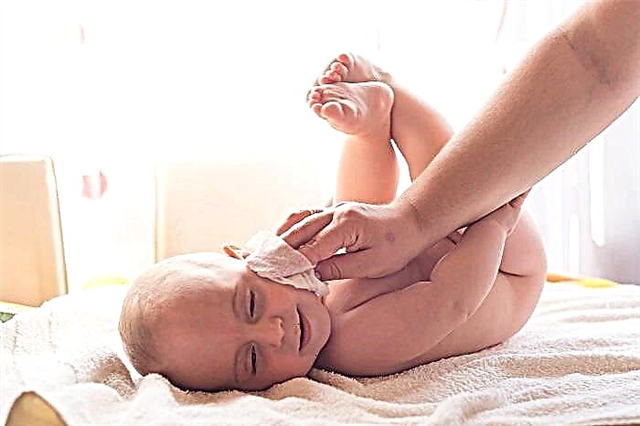
The skin of a newborn is the most delicate thin shell, sensitive to any external and internal influences. She is sensitive to any errors of care, nutrition and other negative factors. Therefore, rashes on the skin of a child are one of the most common causes of parental anxiety.
Before trying to eliminate and treat the rash, you need to clearly understand the cause of its occurrence. But sometimes it is quite difficult to install it yourself. Since there are many reasons for the appearance of a rash, some of them have similar symptoms and are difficult to distinguish from each other. Therefore, it is better to entrust the diagnosis and selection of treatment to a pediatrician. And before the arrival of the doctor, parents will not be superfluous to know the main causes of rashes in children.
The causes of the rash
Prickly heat is the most common rash in babies.
Such a rash is localized in the area under the diaper and in the skin folds. Visually, it resembles small bubbles, around which redness is noticeable. In most cases, prickly heat occurs when the diaper is untimely changed, or when overheating, if the baby is sweating in too warm clothes. Inflammation occurs from excess moisture in which bacteria actively multiply.
Therefore, the first aid for prickly heat is to cleanse the skin and allow it to breathe and stay dry. In pharmacies today there are many drying creams for baby skin.
Timely hygiene, clothing for the weather and the use of special care products will be the best prevention in the fight against prickly heat.
Rash with inappropriate nutrition
Today, everyone knows the common truth that breast milk is the best food for a baby. But even mothers who are breastfeeding are not immune from rashes in babies. Indeed, substances from the products that a woman eats enter into breast milk. And many of them are negatively perceived by the child's body, can cause increased gas formation and fermentation processes in the child's intestines. Such violations of the intestinal microflora break out in rashes.
Most often, such a rash in an infant begins on the face.

The cheeks and chin may turn bright red, and a little later, a small rash appears that is rough to the touch. If left untreated and changes in diet, the rash can descend on the body. Usually it is localized on the bends of the limbs and is manifested by itching. Breastfeeding mothers are advised to follow a diet, especially in the first months after the birth of a baby, in order to prevent such digestive disorders.
But not only children on HB may have a problem with a rash from food. Babies who receive formula milk are more likely to have skin rashes. Most formulas on the market today are cow's milk based meals. Cow's milk protein is a difficult-to-digest product that differs from breast milk protein. Therefore, children's digestion is often not able to fully break down and assimilate it.
If breastfeeding is impossible, modern pediatricians recommend choosing mixtures that are closest in protein composition to breast milk. An example of such a diet would be a goat milk mixture. Goat milk is a lighter product. Its proteins are closer to those of mother's milk, which means that mixtures on such a basis will be better and faster digested, properly absorbed and will not cause digestive problems. As a result, there will be no risk of rashes.

Today, there are not many manufacturers producing goat milk formulas. One of the most reliable manufacturers - brand Kabrita... Their mixture has undergone numerous clinical trials and is approved for feeding infants from the very first days of life.

Many mothers report significant improvements in the well-being of children with formula feeding. Kabrita... It promotes soft digestion, does not provoke colic, regurgitation and constipation. The mixture contains all the necessary vitamins and minerals for the development and growth of the baby. And it is additionally enriched with a complex of pro and prebiotics for the formation of healthy intestinal microflora.
And if the intestines are in order, the rash does not threaten the delicate baby skin.
Contact dermatitis
A rash in a newborn may indicate a reaction to an external stimulus: an inappropriate diaper, cream, powder, bath or laundry detergent. There are many options. A characteristic sign of contact dermatitis will be its clear localization. For example, if the reaction goes to a diaper, then the rash will only appear on the skin underneath. Also, this kind of rash does not have delayed reactions. Redness and inflammation of the skin will appear immediately after contact with an irritating object or product. If you suspect contact dermatitis, you need to protect the child from all possible irritants: change the brand of diapers, choose a hypoallergenic certified eco-powder and bathing agent, and so on.
Infectious rash

Medicine knows many childhood diseases that manifest themselves as a rash on the skin: chickenpox, measles, scarlet fever, rubella, infectious erythema, roseola. In addition to a rash, a symptom of an infectious disease is fever. In such a situation, you should immediately call a doctor!
Before his arrival, you can apply standard symptomatic treatment:
increased drinking regime at elevated temperatures and the use of antipyretic drugs with high rates on the thermometer or feeling unwell.
It is known that the skin is the largest organ in the human body. In infants, the skin is more responsible for thermoregulation than in adults. Children's skin breathes several times more intensively than adult skin. Therefore, the health of the body as a whole directly depends on its condition. In the first months of life, the skin is sensitive to the world around it, adapts to it, and forms defense mechanisms. Therefore, care, nutrition, the choice of hygiene products and timely treatment should be given increased attention.



